(c. 246/248 AD – c. 330 AD)
A Christian saint and the mother of Constantine the Great.
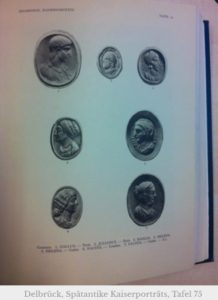
While surfing for info on Tommaso Cades, I came across an article entitled “Helena’s Hidden Gems” on a website called “WRITING HELENA”.
In the article the author, Julia Hillner, describes her beginner’s introduction to engraved gems, which sounded very familiar. She is writing a book about Helena, a Christian saint and the mother of Constantine the Great, which is scheduled to be published later this year.
Julia (the web immediately puts everyone on a first name basis) was searching for images of Helena in Delbrück’s Spätantike Kaiserporträts. She came upon photographs of two intaglio plaster casts purported to be Helena (Middle row in the image at left). They were labeled ns. 4 & 5.
As usual, I immediately went down the rabbit hole.
As part of her introduction to the glyptic arts, Julia located a plaster cast copy (on the left 2nd row, 2nd from left) of the first image, by Tommaso Cades, (photo n. 4) in the Akademische Kunstmuseum in Bonn. The museum’s ancient gem expert agreed with other authorities that it did not represent Helena. New mystery — who is this woman?
She found a plaster cast copy of the second image, again by Tommaso Cades, (photo n.5) in the German Archaeological Institute (DAI) in Rome. The find is documented in her tweet, “Cades Dactyliotheca at the DAI in Rome…” In the photo at the right, top row third from left is a cast of a gem showing Helena, bottom row third from left is Fausta (Helena’s daughter-in-law, the second wife of Constantine the Great).
In a comment below the article Julia wrote: “…although further research and conversations with gem specialists have revealed that it (cast of photo n.5) probably isn’t Helena at all. Having said this, I would be very interested if you find other copies of this portrait and the Fausta one on the row below….”
What a challenge — I set to work.
First. was a search of the trusty James Tassie 1791 Catalogue by R.E. Raspe and the related Beazley Archive image database. This one was easy because the search for “Helena” in the Catalogue (Vol II p.664) quickly led me to, “HELENA, wife of Constantine. 12121] CORNELIAN. —–(With a bezle.) A bust of Helena FL. HEL. “
Searching for No. “12121” in the Beazley Archive’s James Tassie databas found images (original and one with alternate light) that were quite similar, if not identical, to both the photo n.5 in Julia’s original publication and to the Cades’ Helena found at the DAI in Rome. (See images below.)
The entry in the 1791 Catalogue clearly identifies the subject of the gem as “HELENA, wife of Constantine.”
The 1791 Catalogue Indices, “A Reference from the Numbers of the Old (Tassie) Catalogue (1775) to the New.”, indicates that the impression was listed as No. 2404 in the previous 1775 Catalogue (at right). The entry in that Catalogue on p.84 reads, “FLAVIA HELENA, mother of Constantine the Great. Cornelian”
Next, a very good likeness of the n. 5 image was found on the Cades database, also located on the Beazley Archive website. This image seems to be a photo of the trays that Julia viewed at the DAI in Rome. The manuscript catalogue, referenced in the Archive’s introduction, is not available on the Beazley Archive website, nor could it be found on the DAI website. It may provide additional identification information, although Cades was active after Tassie and other possible sources (about 1800 to 1850) so his documentation would probably be based on theirs – recall that the cast was listed in Tassie’s 1775 catalogue.
Helena or Julia Procla — Who?
The mystery of the identity of the subject of the number 4 cast was also solved through the perusal of the Beasley Archive’s James Tassi image database. The image was found to be number 12597. The identification text in the Raspe 1791 Tassie Catalogue states that this was a cornelian in the Florentine Cabinet “Called” Julia Procla, the wife of Probus. The reference to Lippert II 304 was not found. Again, using the old to new numbers index in Raspe, the stone is identified in the Tassie 1775 Catalogue as No. 1478, an “unknown queen” cornelian gem in the Grand Duke’s cabinet (Florence).
“Lippert II 304” (Lippert’s Dactyliothec 1767, .pdf 486/924) in the Tassie entry indicates that, “…the present stone looks very much like…” the bust of Julia Procla as seen on a coin identified in “de Wilde Numism (?)” selection t.8. n. 45. [MyI: Jacob de Wilde (1645–1721) was a coin collector and apparently had authored a catalog]. Lippert continues that, ” The scholars, such as Seguini, Strada, Harduinus and others, are not unanimous as to whether they see Proclus as the wife of the raiser Probus, a grammarian and consul under Marcus Uurelius.” [MyI: The original passage is in German – this is the usual very rough translation].

Fausta or Faustina?
As to the image of Fausta shown below on left, that of Helena in the Cades’ collection viewed by Julia in Rome, it also was found in the Beazley Archive James Tassie database at number 11839 (shown below on the right). It is identified in the Raspe Tassie Catalogue under the sub-heading of the “Heads of Faustina” (main heading “FAUSTINA MINOR”), a cornelian with a reference “Lipp. II. 758). Faustina Minor (c. 130A.D. – 175 A.D.) was also an empress of Rome, but lived about 150 years before Fausta. There is no corresponding image listed in the Tassie 1775 Catalogue.
No reference to Fausta could be found in either Tassie catalogue
The middle image below is from the Beazley Archive Cades database that corresponds to the one Julia viewed in Rome. The apparent differences between the two Cades images is probably due to camera lenses – the cast is located in exactly the same position in both collections, no. 628.
The reference “Lipp. II. 758” from Lippert’s 1767 Dactyliotheca only identifies the gem as being carnelian with no identifying narrative, however, this image in the Tassie database is very similar to one found in the Beazley Archive Lippert database (Lippert’s 1755 Dactyliotheca), First Thousand, Part II, no. 403, also identified as Faustina Minor. You’ll have to take my word for it, as far as the image goes, because there is a reuse restriction plastered across the image. The text identification translates roughly as, “403 Another image of Faustina the lesser, from another source, now certain, is an image in a small gem.”
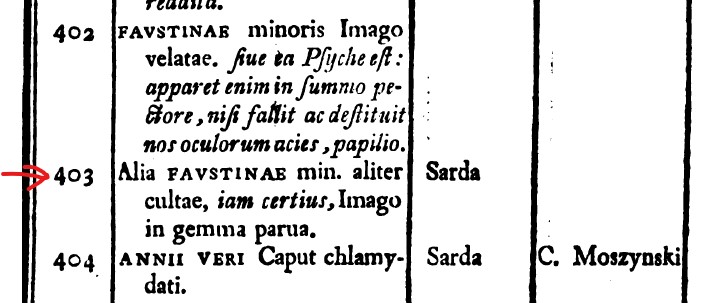
CONCLUSIONS
The identification of the gem in the Tassie Catalogues, as being Helena, would most certainly be based on the inscription on the stone — “HEL.” on the ground at the front of the bust and “FL.” at the rear. This would have been an abbreviation for “Flavia Helena”, Flavia being the family of her husband and often used in her official title. “FLHELENA” was used on many of the coins with her image (click on coin image to enlarge).
In addition, in both the Cades and Tassie collections, the cast is placed among others that depict Constantine and his family.
It’s curious why, as Julia mentioned in her comment, “…further research and conversations with gem specialists have revealed that it probably isn’t Helena at all.”
There is no source, i.e., possessor or cabinet noted in either Tassie Catalogue description, therefore it seems probable that the mold was not an original taken by Tassie (who usually listed that information, if it was known or if he made the original mold), but obtained from some other molder such as Lippert, Stosch or Dehn. Regrettably, a quick scan of the available databases of works by these individuals did not result in finding a copy of the impression.
The indication that the original gem was “cornelian” suggests that there was some documentation with the mold, whatever its source.
It’s very possible that the original cornelian gem is not contemporaneous with Helena but, in fact, was engraved at some later date, based on images on coins, etc. It would take examination by an expert to opine on the likely date that the original stone was engraved.
Also, it’s interesting to note that the inscriptions would have read correctly on the original cornelian stone. Normally, letters and symbols are shown in mirror image on the intaglio so they read correctly on a cast or seal.
The “Fausta” image.
Its clear that Cades identified the woman’s image as Fausta because the impression is placed amongst other impressions of Constantine in his collection, however, it’s difficult to understand why he would do that in light of the identification as Faustina Minor by at least two molders who went before him and of whose collections and catalogues he was keenly aware. Just a difference of opinion?
Based primarily on the fact that both Tassie and Lippert identify the image as Faustina Minor and that they made these assertions some 50 or more years before Cades opined it was Fausta, it is highly likely that this is an the image of Faustina Minor
The other indicator that this image is of Faustina Minor and not Fausta is demonstrated through comparison of hairdos. The coins of Fausta have a completely different hairdo whereas the coins of Faustina have ones quite similar to the plaster impressions.
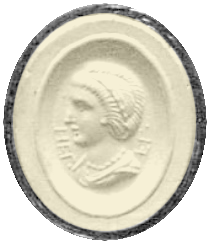
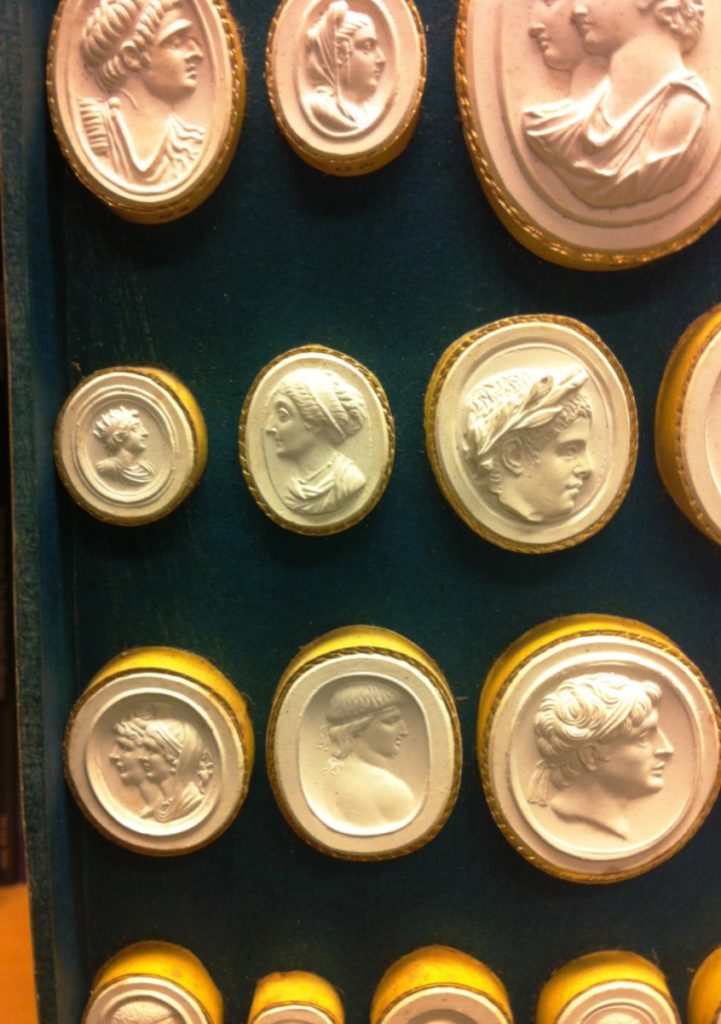
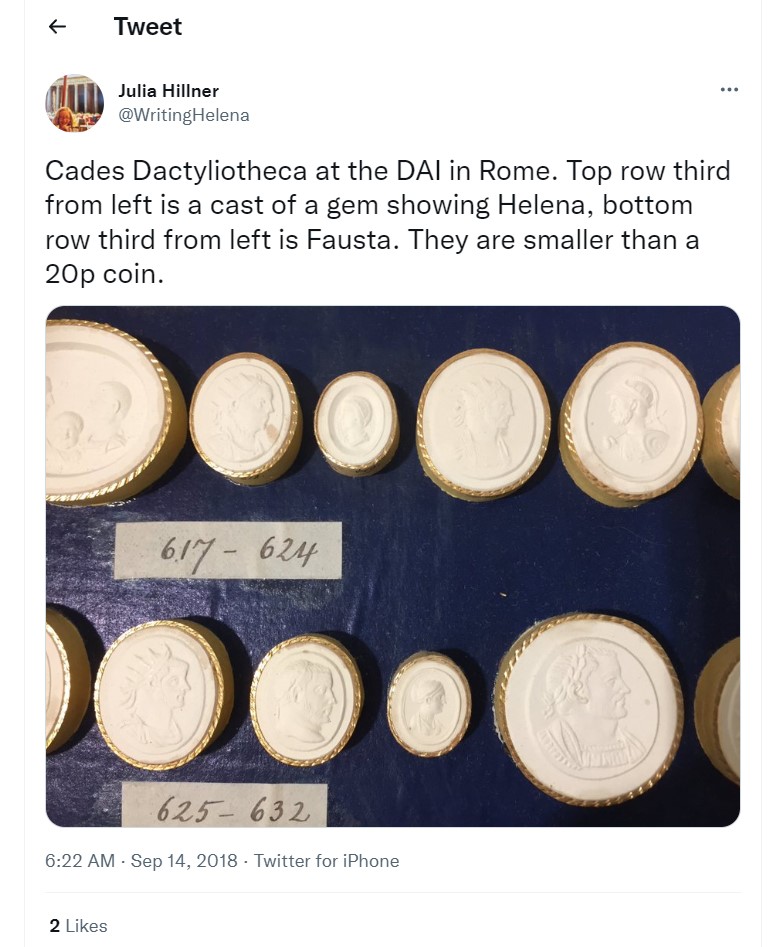
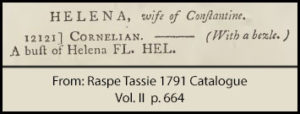
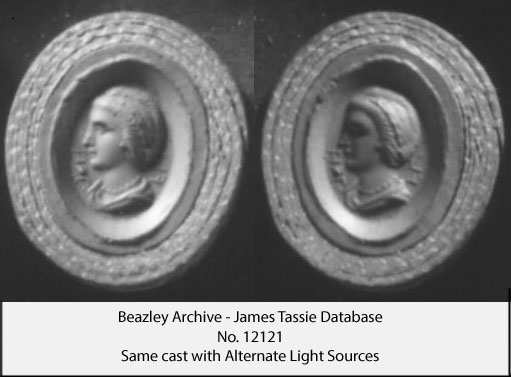
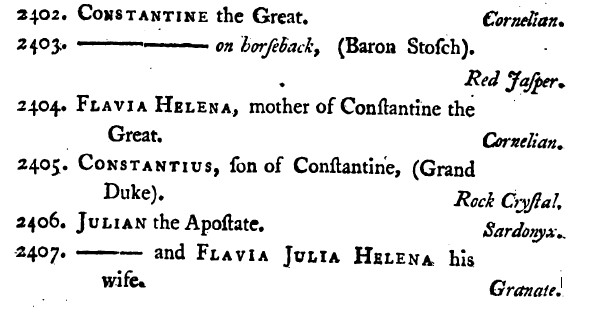
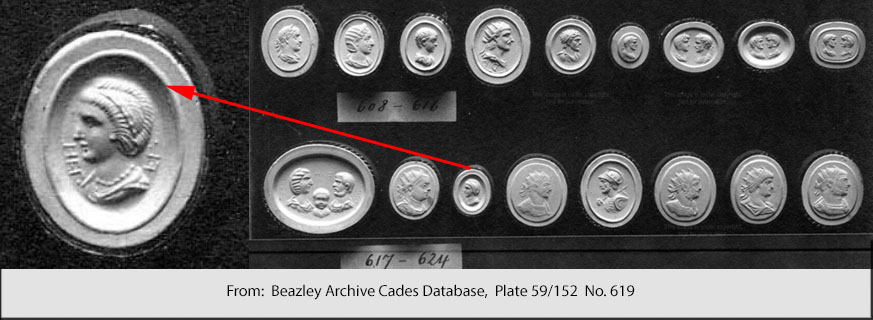
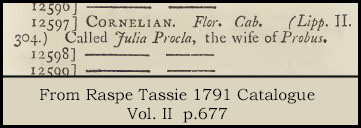
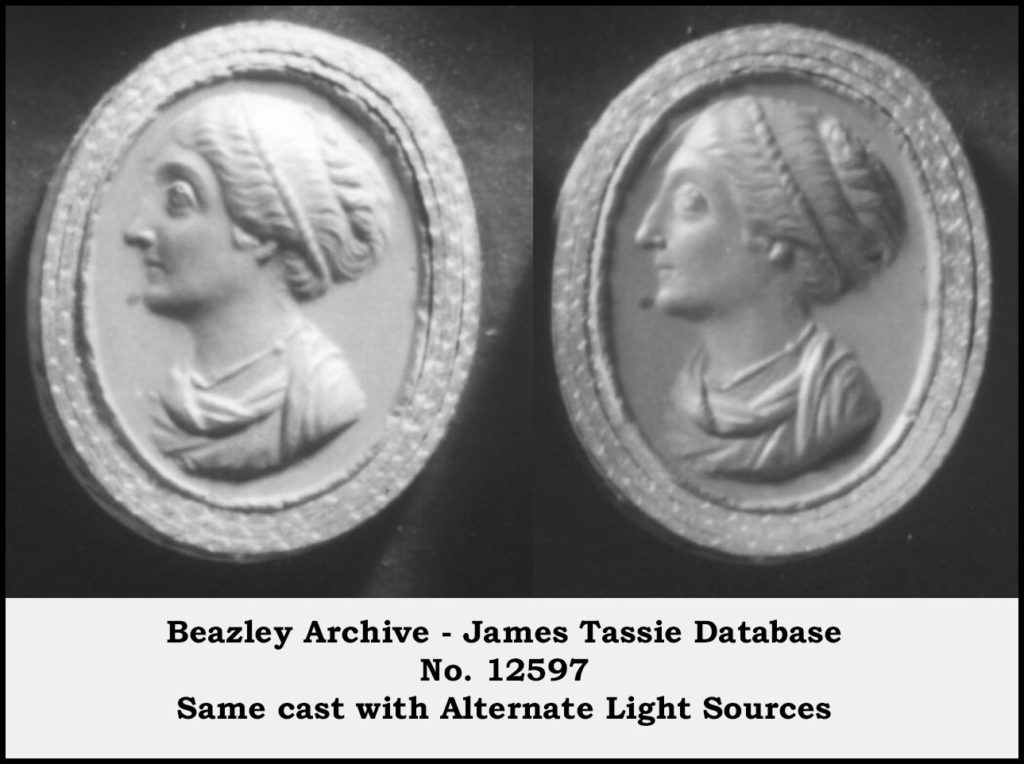
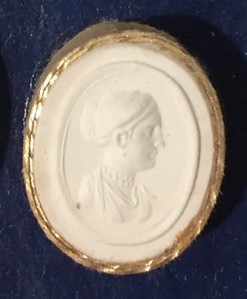
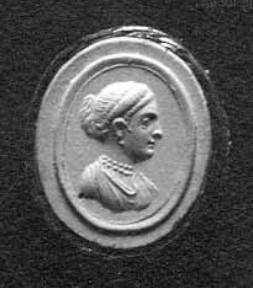
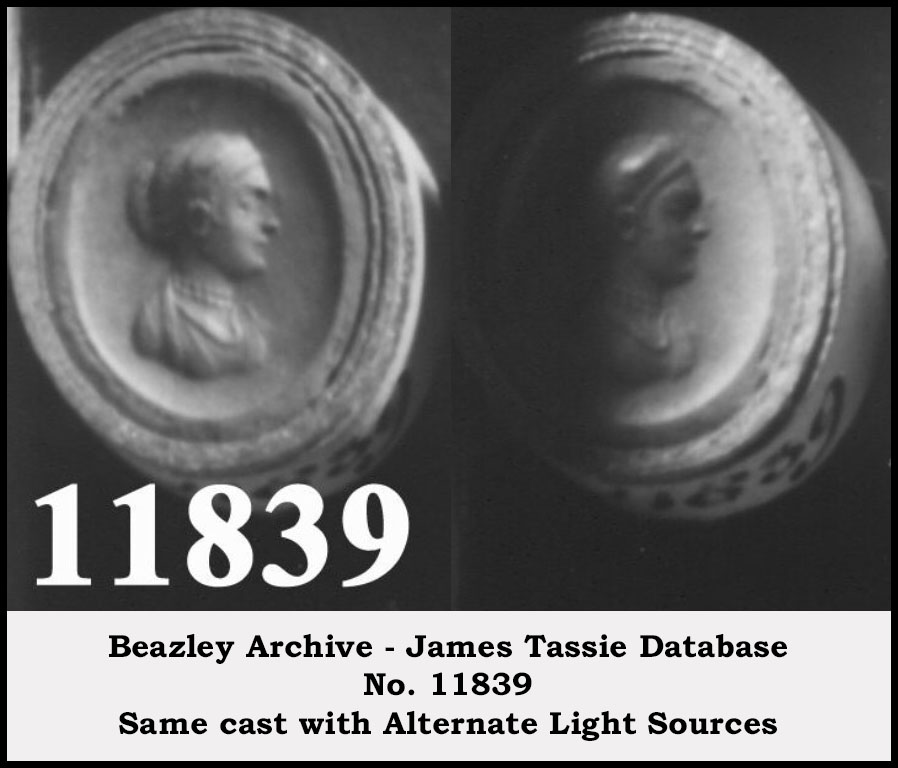
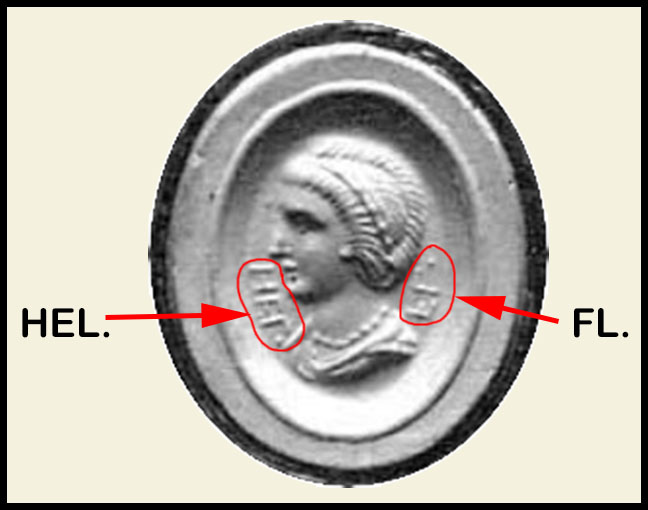
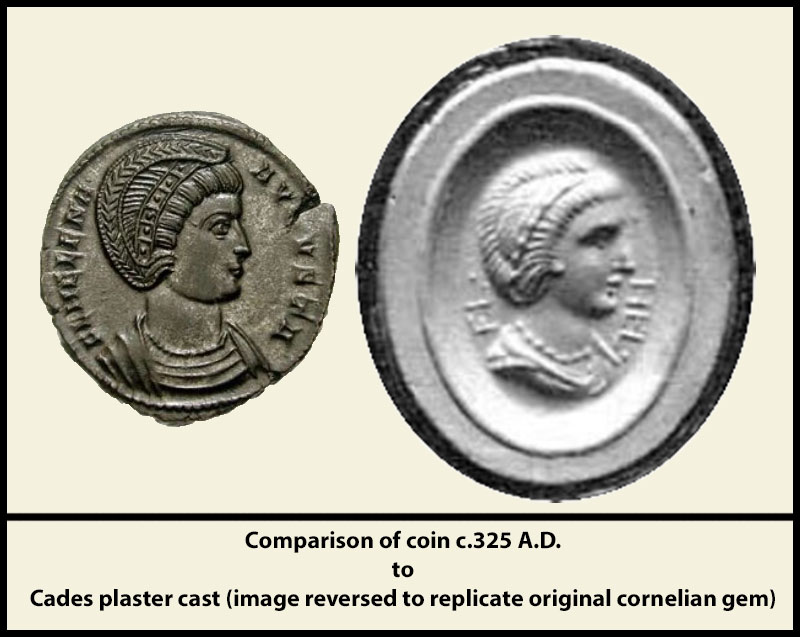
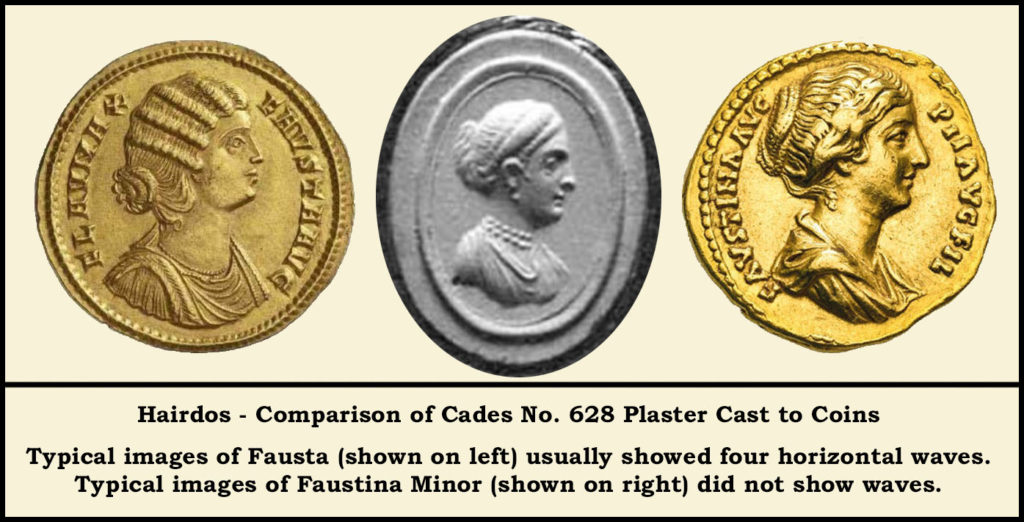
What a wonderful blog – thank you so much for picking up the trail and all this great information! It is very interesting that you think n. 5 may be a later copy of a coin portrait or similar of Helena. Jeffrey Spier (2007), Late Antique and Early Christian Gems, Wiesbaden: Reichert, dismisses identification as Helena (as he does for Delbrueck’s n. 4). I am glad that there is more to say about these!!